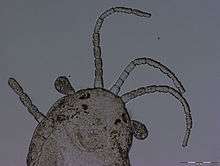Nerilla antennata
| Nerilla antennata | |
|---|---|
 | |
| Nerilla antennata | |
| Scientific classification | |
| Kingdom: | Animalia |
| Superphylum: | Lophotrochozoa |
| Phylum: | Annelida |
| Order: | Polychaeta |
| Family: | Nerillidae |
| Genus: | Nerilla |
| Species: | N. antennata |
| Binomial name | |
| Nerilla antennata Eduard Oscar Schmidt, 1848 | |
Nerilla antennata is 1–2 mm coulorless meiofaunal polychaete. It is often found in aquaculture.
Morphology
Nerilla antennata has nine segments with chaetae and a prostomium with two very large clavate palpates and three segmented tentacles. On the prostomium it has four eyes and two cilliated nuchal organs on the side. The other segments has both dorsally – and ventrally parapods with simple chaetae. The peristomium has two segmented anal cirri.
Male specimens can be identified by three pairs of gonoducts at segment 6 - 8. Females have ovaries at segment 6 and oviducts at segment 7. [1][2]
Ecology
The marine species. Nerilla antennata lives interstitially (between grains of sand) and between algae. It is widely distributed with findings in European waters and around New Zealand. WoRMS The larval development has no pelagic stadium. [3]
Systematics
Generally the family Nerillidae has few segments, two palpates and up to three tentacles.[4] The family includes the 15 marine genera. WoRMS
References
- ↑ Kirkegaard J. B. (1996). "Danmarks Fauna". 86 (Havbørsteorme. II. Sedantaria ed.). Dansk Naturhistorisk Forening: 245–246.
- ↑ Westheide W. (1990). "Synopses of the Britiah Fauna". 2 (Polychaetes: Interstitial Families ed.). Universal Book Services for the Linnean Society of London and the Estuarine and Coastal Sciences Association: 56–57.
- ↑ Kirkegaard J. B. (1996). "Danmarks Fauna". 86 (Havbørsteorme. II. Sedantaria ed.). Dansk Naturhistorisk Forening: 245–246.
- ↑ Higgins R. P. and Thiel H. (1992). "Introduction to the Study of Meiofauna". Smithsonian Institution Press: 334.
External links
- [www.marinespecies.org/aphia.php?p=taxdetails&id=130437]
